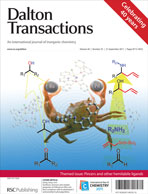The reaction of RH (1) with Hg(OAc)2, in EtOH, gave the acetate RHgOAc (2) [R = 2,6-[O(CH2CH2)2NCH2]2C6H3]. The corresponding RHgCl (3) was obtained from 2 and LiCl. The reaction of 3 with TeCl4 (1 : 1 molar ratio), in anhydrous 1,4-dioxane, resulted in the transfer of the organic ligand from mercury to tellurium and the isolation of the unexpected ionic compounds [RTe]2[Hg2Cl6] (4) and [RH3][HgCl4] (5). The molecular structures of 1–4 and 5·H2O were established by single-crystal X-ray diffraction. The acetate 2 and the chloride 3 are monomeric in solid state. In both mercury and tellurium organometallic compounds the organic group acts as an (N,C,N) “pincer” ligand. This coordination pattern provided stability for the rare [RTe]+ cation. Weak cation–anion interactions [Te⋯Cl 3.869(3) Å] are present between [RTe]+ and the dinuclear anion [Hg2Cl6]2− in the crystal of 4. Theoretical calculations with DFT methods were performed for models of 3 and 4. The results show that in the cation of 4 the coordination of the nitrogen atoms play an important role for the stabilization of the structure found in the crystal whereas in 3 the coordination of the nitrogen atoms to the metal centre stabilizes to a less extent the structure found in solid state.
![Graphical abstract: Organomercury(ii) and tellurium(ii) compounds with the “pincer” ligand 2,6-[O(CH2CH2)2NCH2]2C6H3 – stabilization of an unusual organotellurium(ii) cationic species](/en/Image/Get?imageInfo.ImageType=GA&imageInfo.ImageIdentifier.ManuscriptID=C1DT10414D&imageInfo.ImageIdentifier.Year=2011)
You have access to this article
 Please wait while we load your content...
Something went wrong. Try again?
Please wait while we load your content...
Something went wrong. Try again?
![Graphical abstract: Organomercury(ii) and tellurium(ii) compounds with the “pincer” ligand 2,6-[O(CH2CH2)2NCH2]2C6H3 – stabilization of an unusual organotellurium(ii) cationic species](/en/Image/Get?imageInfo.ImageType=GA&imageInfo.ImageIdentifier.ManuscriptID=C1DT10414D&imageInfo.ImageIdentifier.Year=2011)

 Please wait while we load your content...
Please wait while we load your content...